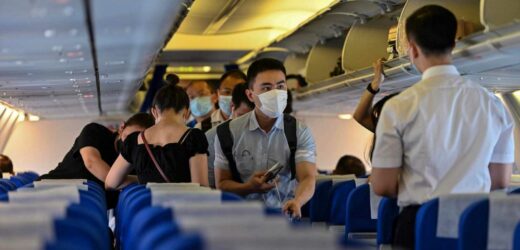BRITS are slowly returning to the skies after nearly four months of grounded flights and border closures due to the coronavirus crisis. Yet travellers have one main concern regarding their next holiday – is it safe?
According to one study, the most dangerous part of the flight where you are more likely to catch coronavirus isn't while you are in the air at all.
Instead, it is when passengers are boarding and disembarking.
A German study found it is not necessarily during the flight, as this is when the ventilation systems are up and running.
Computer simulations found it was during boarding and disembarking when passengers were most at risk, the Journal reported.
That’s when passengers are in even closer contact — queuing in aisles, looking for seats, and moving bags in and out of the overhead compartment.
When ventilation systems are running during a flight, the air on the plane is thought to be completely replaced every 2-3 minutes, compared with every 10-12 minutes in an air conditioned building, the BBC reported.
The air we breathe in the plane cabin is a 50-50 mix of outside air and recirculated air from inside the cabin, which has passed through hospital-grade HEPA filters that can remove at least 99.9 per cent of bacteria and virus particles.
“It is generally accepted right now that when the plane is in flight and the ventilation system is up and running, it does a really good job of clearing the air of infectious particles,” disease transmission expert Dr Mark Gendreau told the Journal.
But the ventilation systems are less effective with handling large droplets, so experts believe the bigger risk on planes is from passengers coughing and sneezing nearby.
That’s why masks can be important, and why some experts believe the window seat — which offers less exposure to other people — is the best place to avoid those large droplets.
Airlines have been forced to take drastic measures to reduce the risk of Covid-19 on aircraft and reassure travellers of their safety in the air.
Some have changed their boarding and deplaning process to maintain some level of physical distancing.
Virgin Australia, for example, boards passenger in smaller sections and on arrival, passengers are asked to remain in their seats so the plane can be emptied row by row.
Boeing has issued an advisory — which airlines don’t have to follow — that on-board power is used to keep ventilation systems running at full strength during boarding and deplaning.
Some airlines choose to do this anyway, while others don’t.
EasyJet and Ryanair require passengers to wear face masks the entire duration of the flight, along with British Airways who also warn passengers to have enough masks for a long-haul flight.
Other new measures include additional cleaning between flights, as well as a reduction of in-flight services such as duty-free and meal options.
While there have been notable cases linked to flights — a Jetstar flight was flagged just yesterday for having a confirmed case on board — globally, there are few known cases of Covid transmission inside aircraft, The Wall Street Journal reports.
In May, a flight from Madrid to Lanzarote with 140 people on board was quarantined on arrival after a passenger tested positive for the coronavirus while in the air.
Most read in News Travel
UNITED LATEST Dembele linked with United move, Cristiano Ronaldo joins United WhatsApp
Utd's Greenwood arrested on suspicion of rape & GBH as cops seen at star's house
Mason Greenwood faces police probe after arrest on suspicion of rape & assault
Wycombe's Akinfenwa furiously confronts MK Dons fans over abusive chant
The other key thing for passengers to remember is how easily the virus can be stopped through simple hygiene habits.
“Contrary to what people think, the hands are the way that these viruses most efficiently spread,” Dr David Powell, medical adviser of the International Air Transport Association, told Bloomberg.
“Top of the list is frequent hand washing, hand sanitising, or both.”
A version of this article was originally published on news.com.au and has been reproduced with permission.
Source: Read Full Article









